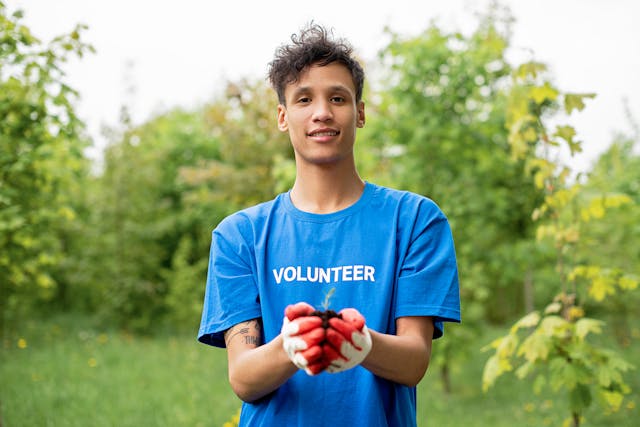10 Eco-Friendly Projects to Build a Sustainable Community
Building a sustainable environment at the grassroots level is not only ideal but essential in today’s world. While global leaders and large corporations work on addressing environmental challenges, real, long-lasting change often begins within our communities. Small, intentional projects not only help the environment but also educate and inspire others to adopt more eco-friendly habits. The goal is not to impose change aggressively but to encourage thoughtful decision-making through persuasion, education, and involvement.

In This Article
- Why Community Sustainability Matters
- What Is a Sustainable Community?
- #1. Advocate for Tree Planting
- #2. Establish a Community Garden
- #3. Eat Locally and Support Organic Farms
- #4. Establish a Neighbourhood Compost Bin
- #5. Volunteer for Eco-Friendly Causes
- #6. Join a Community Supported Agriculture (CSA) Program
- #7. Advocate for Electric Vehicle (EV) Charging Stations
- #8. Reuse Items for Creative Arts and Design
- #9. Encourage More Recycling
- #10. Advocate for Green Building Practices
Why Community Sustainability Matters
You might think, “I live sustainably at home—why does it matter what my community does?” The reality is that a sustainable community directly impacts your well-being. Even if your home is eco-friendly, a polluted, unsustainable neighbourhood can affect the quality of air, water, and food you rely on. Climate change, urban pollution, and increasing weather events—such as heat waves and flooding—highlight the need for collective action. We’re all in this together, and change starts when individuals come together as a community.
I learned this firsthand when my neighbourhood rallied around the idea of creating a community garden. We wanted a space that fostered sustainable practices while also serving as a gathering place. What started as a small idea among a few neighbours blossomed into a thriving community hub that supplies fresh, organic produce, reduces food waste, and teaches others how to grow sustainably. It wasn’t just about the garden—it was about shifting mindsets toward long-term environmental stewardship.
In this article, I’ll walk you through 10 eco-friendly projects you can start in your community. These aren’t just ideas—they’re backed by success stories, expert insights, and data that show their potential impact. With clear instructions and actionable advice, you’ll have the tools to lead your community toward a greener future.
What Is a Sustainable Community?
A sustainable community is designed to meet present and future needs without compromising environmental, social, or economic health. This holistic approach ensures that all aspects of life—urban infrastructure, local economies, environmental stewardship, and social equity—are in balance.
According to the U.S. Environmental Protection Agency (EPA), creating sustainable communities involves working with local governments, tribal territories, and various organisations to improve quality of life. These communities embrace “smart growth,” which prioritises environmental protection, public health, and economic stability through sustainable practices.
But here’s what makes it personal: every sustainable community begins with one person or a small group taking the initiative. By starting with small, manageable projects, you can make a tangible impact. In the following sections, I’ll outline 10 projects, supported by real-life examples and expert data, to get you started on your sustainability journey.
#1. Advocate for Tree Planting
Trees are often called the “lungs of the Earth” for a reason. They absorb carbon dioxide and release oxygen, purify air, and create habitats for wildlife. Beyond the obvious environmental benefits, trees also enhance mental well-being. Studies have shown that spending time around trees reduces stress and anxiety, improves mood, and even boosts cognitive function.
I’ll never forget the tree-planting initiative we organised after a local elementary school lost several trees during a storm. We partnered with a local nursery to source native species, and within a few months, the barren schoolyard was transformed into a green sanctuary. Not only did this project improve the local ecosystem, but it also gave the children a sense of ownership and pride in their surroundings.
How to Start a Tree Planting Project:
- Research Native Trees: Contact local environmental agencies or nurseries to find out which trees thrive in your area.
- Find a Space: This could be a public park, a schoolyard, or even empty lots. Reach out to local authorities for permission.
- Involve the Community: Engage local schools, environmental clubs, or neighbours to help with planting.
- Fund the Project: Consider crowdfunding or applying for grants. The Arbor Day Foundation offers grants for tree-planting projects.
Impact Data:
According to the National Forest Foundation, planting 20 million trees would sequester about 1.6 million metric tons of carbon dioxide annually—the equivalent of taking 300,000 cars off the road. Every tree matters, and your community can make a significant contribution to combating climate change.
#2. Establish a Community Garden
In urban areas, green space can be hard to come by, but a community garden can transform an underused lot into a thriving source of fresh produce and connection. Community gardens not only improve access to fruits and vegetables but also foster a sense of belonging. It’s an ideal project for urban areas where many residents may not have access to personal gardens.
Our community garden started as a small plot of land but grew to serve dozens of families. The benefits were clear: participants were able to reduce their grocery bills, eat more nutritious food, and, perhaps most importantly, build relationships with their neighbours. We even incorporated educational workshops on organic gardening, composting, and water conservation.
How to Start a Community Garden:
- Find a Location: This could be an unused lot, a section of a park, or a schoolyard.
- Get Permission: You’ll likely need permission from your local government or property owner.
- Gather a Team: Partner with local gardeners, environmental groups, or schools to get people involved.
- Secure Funding: Local businesses or grants from organisations like the American Community Gardening Association can help.
Impact Data:
Research from the University of California found that community gardens increase residents’ fruit and vegetable consumption by nearly 60%, significantly improving dietary health. Additionally, gardens reduce neighbourhood crime rates, as areas become more frequented and well-maintained.
#3. Eat Locally and Support Organic Farms
Supporting local, organic farms reduces carbon emissions, supports local economies, and promotes healthier diets. But beyond just buying local produce, you can also encourage your community to do the same. Host a “locally grown” day at your community centre or work with local restaurants to feature locally sourced meals.
I’ve found that organising a local farm-to-table event not only helped support nearby farmers but also educated the community about the environmental benefits of reducing food miles—the distance food travels from farm to consumer. This small initiative grew into a monthly farmer’s market where community members now regularly buy fresh, organic produce.
How to Encourage Local Food Consumption:
- Promote Farmers Markets: Help local farmers gain visibility by organising or promoting farmers’ markets.
- Host Farm Tours: Partner with local farms to offer community tours, educating people on sustainable farming practices.
- Coordinate Community Dinners: Host monthly or seasonal community dinners that feature local produce.
Impact Data:
According to a study from the journal Agriculture and Human Values, locally-grown food travels an average of 56 miles from farm to table, compared to over 1,500 miles for non-local food. By reducing transportation, we lower carbon emissions and promote fresher, healthier eating habits.
#4. Establish a Neighbourhood Compost Bin
Food waste is a significant contributor to climate change. In fact, the EPA reports that food waste is responsible for nearly 8% of global greenhouse gas emissions. But this waste doesn’t have to end up in landfills. By establishing a neighbourhood composting program, you can turn food scraps into nutrient-rich compost for local gardens and farms.
In our community, we created a shared compost bin that has reduced food waste by nearly 30%. We collaborated with a local farm, which now uses compost in exchange for discounted produce. The project not only reduced waste but also strengthened our relationship with the farm and provided us with fresh food at a lower cost.
How to Start a Compost Program:
- Build or Buy a Compost Bin: A large, durable compost bin can be set up in a shared space.
- Educate the Community: Create flyers or host a workshop on what materials can be composted and the benefits of composting.
- Partner with Local Farms: Many small farms are eager to receive compost donations.
Impact Data:
The U.S. Composting Council reports that composting reduces methane emissions from landfills by up to 90% and enriches the soil with essential nutrients. This simple project has the potential to create a closed-loop system within your community, where waste becomes a valuable resource.
#5. Volunteer for Eco-Friendly Causes
One of the most straightforward ways to make a difference is by volunteering for environmental causes. Whether it’s organising a local cleanup, planting trees, or promoting recycling initiatives, your involvement can inspire others to get on board.
In my experience, organising a community cleanup not only made our neighbourhood visibly cleaner but also strengthened our community bonds. The simple act of spending a few hours picking up trash alongside neighbours turned into meaningful conversations about our shared environment. The momentum from that first event led to monthly cleanups, and now we have a cleaner, greener community that’s proud of its efforts.
How to Get Involved:
- Find Local Events: Many local environmental organisations host regular events like cleanups or tree planting. VolunteerMatch.org is a great resource for finding eco-friendly volunteering opportunities.
- Start Your Own Event: If your community doesn’t already have volunteer events, take the initiative to organise one. Start small—perhaps a neighbourhood cleanup—and invite others to join.
Impact Data:
A study by the UK’s Royal Horticultural Society found that areas with frequent community cleanups reported a 26% decrease in littering. Even small efforts can have a big impact when it comes to improving local environments.
#6. Join a Community Supported Agriculture (CSA) Program
Community Supported Agriculture (CSA) programs connect consumers directly with local farmers. By joining a CSA, you not only receive a steady supply of fresh, seasonal produce but also support sustainable farming practices that are better for the environment.
I’ve been a member of a local CSA for years, and it’s transformed the way I think about food. Not only do I get the freshest produce, but I also know that I’m supporting farmers who are committed to sustainable agriculture. Plus, the variety of seasonal veggies pushes me to try new recipes and eat more mindfully.
How to Join or Start a CSA:
- Research Local CSAs: Look for CSA programs in your area using directories like LocalHarvest.org.
- Organise a Group Membership: If your community doesn’t have a local CSA, consider partnering with a nearby farm to start one. The farm benefits from the upfront funding, and the community enjoys fresh, local food throughout the season.
Impact Data:
According to research by the National Centre for Appropriate Technology (NCAT), CSA members tend to waste less food, as they are more mindful of their produce supply and plan meals around what’s in season.
#7. Advocate for Electric Vehicle (EV) Charging Stations
As electric vehicles (EVs) become more popular, the demand for charging stations increases. Yet, many communities still lack adequate EV infrastructure. By advocating for the installation of communal car chargers, you can help reduce reliance on fossil fuels and make it easier for residents to switch to EVs.
We saw this firsthand when a group of environmentally conscious neighbours worked with our local government to install the first public EV charging station in our town. Now, more people are making the switch to electric cars, knowing they have a reliable place to charge. The station even became a gathering point, where EV owners share tips and stories, fostering a stronger community.
How to Advocate for EV Chargers:
- Research Incentives: Many governments offer grants or incentives for installing EV charging stations. Research options through your local or state government.
- Partner with Businesses: Many businesses, such as grocery stores or shopping malls, may be open to installing charging stations to attract customers.
- Engage Local Officials: Work with local government or city planners to identify high-traffic areas that could benefit from public chargers.
Impact Data:
According to the International Energy Agency (IEA), electric vehicles accounted for nearly 10% of global car sales in 2023, with the trend continuing upward. Communities that offer accessible charging stations are more likely to see an increase in EV adoption, reducing overall greenhouse gas emissions from transportation.
#8. Reuse Items for Creative Arts and Design
Rather than throwing away old household items, why not repurpose them into something beautiful? Upcycling is a creative way to reduce waste while also adding value to what might otherwise be considered junk. From turning old furniture into stylish home decor to using discarded materials for community art projects, the possibilities are endless.
One of the most memorable projects in our community involved an upcycling art workshop. Local artists and residents came together to turn discarded materials—old tyres, broken furniture, and scrap metal—into sculptures and public art installations. Not only did we reduce waste, but we also beautified our public spaces and inspired others to see the creative potential in everyday items.
How to Start an Upcycling Project:
- Collect Materials: Ask your neighbours to donate old or broken items that can be repurposed.
- Host a Workshop: Partner with local artists or craftspeople to lead a workshop on upcycling techniques.
- Display the Results: Create a public art installation or showcase the upcycled items at a community event.
Impact Data:
According to the Environmental Protection Agency (EPA), Americans generated 292 million tons of municipal solid waste in 2018. Upcycling reduces the need for new materials and keeps waste out of landfills, contributing to a circular economy where materials are reused rather than discarded.
#9. Encourage More Recycling
Recycling is one of the simplest ways to reduce waste, but many communities still struggle with proper recycling habits. By promoting recycling initiatives in your neighbourhood, you can help divert waste from landfills, conserve natural resources, and reduce pollution.
Our neighbourhood recycling program started as a simple flyer campaign but grew into a full-fledged initiative with the support of local schools and businesses. We organised a recycling drive that collected thousands of pounds of materials that would have otherwise ended up in landfills. The best part? It brought the community together around a shared cause, and now we have regular recycling drop-offs in place.
How to Promote Recycling:
- Educate the Community: Distribute flyers or host a workshop on what materials can be recycled and where to take them.
- Partner with Local Businesses: Many businesses are happy to host recycling bins or sponsor community recycling events.
- Organise a Recycling Drive: Set up a collection point where residents can drop off recyclables like glass, paper, and electronics.
Impact Data:
According to the EPA, recycling can reduce greenhouse gas emissions by 2.5 metric tons of carbon dioxide equivalent per ton of material recycled. By promoting recycling in your community, you can help reduce the overall carbon footprint and preserve valuable resources.
#10. Advocate for Green Building Practices
Sustainable building practices—such as using renewable materials, incorporating energy-efficient designs, and minimising waste—are crucial for reducing the environmental impact of new construction. By advocating for green building standards in your community, you can help ensure that new developments are environmentally friendly and energy-efficient.
In our town, we worked with local builders and city planners to adopt green building guidelines for new homes and public buildings. The result? Energy-efficient homes that use less water and electricity, saving homeowners money and reducing the community’s overall carbon footprint.
How to Advocate for Green Building:
- Research Green Building Standards: Familiarise yourself with programs like LEED (Leadership in Energy and Environmental Design) or local green building codes.
- Work with Local Builders: Partner with contractors, architects, and city planners to encourage the use of sustainable materials and designs.
- Promote Incentives: Many governments offer tax credits or incentives for building energy-efficient homes. Share this information with local developers and residents.
Impact Data:
According to the U.S. Green Building Council, buildings account for 39% of global carbon emissions. Green building practices can reduce energy use by 30-50% and water use by up to 40%, making a significant impact on sustainability efforts.
Conclusion: Creating a Sustainable Community Starts with You
Building a sustainable community doesn’t require grand gestures or expensive initiatives. It starts with small, meaningful actions that grow into larger movements over time. By advocating for tree planting, community gardens, composting, recycling, and other eco-friendly projects, you can lead your neighbourhood toward a greener, healthier future.
As you embark on this journey, remember that every project—no matter how small—makes a difference. With the right mindset and a willingness to engage your community, you have the power to create lasting change. It’s not just about protecting the environment—it’s about building a community that thrives together.
Let’s take the first step, one project at a time, toward a more sustainable future.







